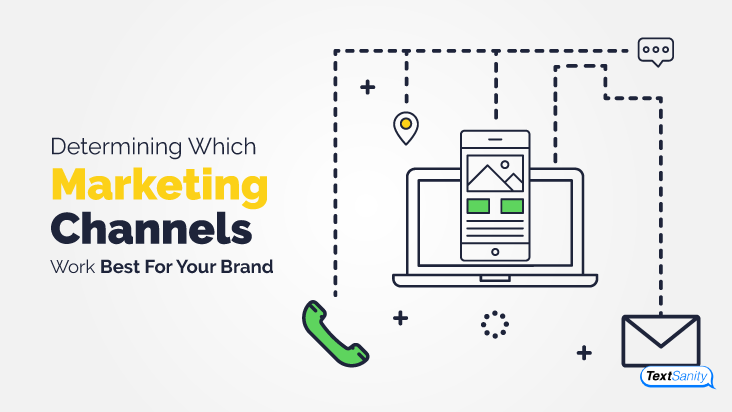Determining Which Marketing Channels Work Best for Your Brand
Marketing is, ultimately, a planning process and execution to distribute ideas and information that facilitates the exchange of goods and services. Your product meets an unfulfilled demand a consumer has. Marketing is simply how we communicate our readiness to meet customer demand. In other words, determining which marketing channels work best for your brand means you’ll meet customer demand head on.

The relationship between consumer and business relies on a symbiotic relationship which is mutually beneficial. Successful marketing, driven by solutions, perfect the relationship where both parties benefit.
People often confuse marketing for advertising. But marketing is so much more. For example, customer support, media planning, product pricing, and strategic sales all depend on marketing.
Marketing is everything a brand or company does to create and maintain a relationship with consumers. Like any relationship, it’s so much more than an initial meeting. Relationships, especially business-to-consumer relationships, need maintenance to grow.
Communication is key to building relationships, and therefore, communication is key to effective marketing.
Think about how you communicate with people in your life. Some people you text, some people you call on the phone, and some people you email. In the same way, there are different marketing channels because each reaches customers in a different way.
Read on to learn how to determine what channels work best for your brand.

Marketing channels
How do you determine if something qualifies as a marketing channel? Easy! Any platform, medium, or method a brand or company uses to market products or services to consumers is a marketing channel. The primary objective: to consume products, is central to marketing.

Marketing channels include:
- Print Marketing: Flyers, brochures, magazine ads.
- Social Media: Twitter, Instagram, Facebook, LinkedIn, etc. “Like and follow for more.”
- SMS Marketing: Short messages to consumers via text.
- Email Marketing: Email signatures and tags, banners, newsletters, etc.
- Websites: These are your blogs, FAQ page, about page, etc,
- Word of Mouth: What you do, who you are, and what you’re about.
- Search Engine Optimization (SEO): Appropriate title tags, meta descriptions, keyword search results, etc.
- Referrals: Websites referencing your page or your company directory.
- Pay-per-click (PPC) Marketing: Advertiser pays a publisher when the ad is clicked.
As you now know, each channel is different. Some are more measurable, while others are amorphous. Some are personal, some are general. And some are specific, some are broad. Examples of marketing channel applications follow.
![]()
10 examples of marketing channel applications
- In-store Signage
- QR Codes
- TV and Radio Commercials
- Mass Text Messaging
- Press Releases
- Blogs
- Social Media Network
- Affiliate Marketing
- Apps

So many more marketing channels exist than the ones listed above. Plus, narrowing further within these examples gives an in-depth look at marketing channel applications. With so many marketing channels available to companies and brands, brands need a focused effort putting the examples in practice.
![]()
Channel examples in practice
Remember communication differs with different people, so implementing more than one channel to communicate with consumers is necessary. However, don’t let the vast supply of options overwhelm you. Not all your time, attention, and money needs to go to every channel available. It’s better to be the master of some than the slave to all.

A few channels tend to be the most effective for most companies. They are listed below.
- Websites: When was the last time you were willing to try a new company that didn’t have a website? They are so commonplace that a company not having a website can seem like a red flag to consumers. Websites can be simple and straightforward, but companies that have one are usually more successful in their marketing efforts.
- SEO: Search Engine Optimization (SEO) goes hand-in-hand with your website. SEO efforts are vital to driving website traffic. A website is great, but you need your site seen before competitors’ sites. When you do, you introduce new customers to your product.
- Email Marketing: Consumers still opt-in to email, and the ROI on email campaigns remains a decent part of marketing strategies. They remotely pique a consumer’s interest in promotional events, sales, and updates. Unlike websites and SEO, a consumer doesn’t need to be looking for you or your product to find you.
- SMS Marketing: Everyone is texting now. Every demographic uses texting and cell phones more than they did five years ago. Text message marketing provides a direct, timely message to consumers in real-time. There’s no other way to gain instant access to your customer’s attention. It’s growing in use and popularity, and becoming an integral part of successful marketing campaigns.
- Video/YouTube: We live in a world of snippets. Our society loves to be visually stimulated, but its collective attention span has decreased over time. For this reason, marketing has moved into the world of videos within videos. YouTube is ranked second in the world’s largest search engines. Like a website, it’s better to market via video than not.
- PPC: Pay-per-click marketing takes ready-to-buy customers and directs them to you at a higher rate than an organic search. You still need organic search, but the conversion results of PPC are undeniable.
We highly recommend including the above channels in a marketing strategy because they integrate well with one another. For example, SMS marketing incorporates direct links with websites and videos. PPC works in tandem with SEO to increase conversion rates and consumer traffic.
Additionally, more conventional methods work well with these strategies too. An example: opt-in instructions for SMS marketing on flyers. QR Codes displayed on in-store signage drive website traffic. A shared video goes viral and creates a classic “water-cooler” conversation.
![]()
What channel works for my brand?
Marketing is an ever-evolving part of your brand and business. Using a channel or not using a channel right now may not mean you’ll always or never use it in the future. Adjusting your strategy as your needs change promotes growth.

It’s important to determine what marketing channels you currently use. Once you do, ask yourself and your team which channels you want to add to your strategic marketing plan. Likewise, evaluate the existing channels and weed out the fruitless ones. Some things to consider when evaluating your current marketing channels:
- Budget. Will you save money by pausing ineffective channels? Is it enough to pay for channels you want to add?
-
Manpower. Do you have time to grow in a new channel unfamiliar to you? Is there a similar channel better to start with?
-
Objectives. Do you need to increase sales with existing consumers? Do you need to improve public relations? Are you conversion-driven? This is an opportunity to consider your current marketing channel objectives..
Evaluate your marketing strategy based on these questions. This gives you direction in determining the effectiveness of your campaigns and helps you choose the best channel.

How to determine the effectiveness of a channel
The effectiveness of a channel depends on whether or not you’re achieving your goals. When it comes to goals, think SMART: Specific, Measurable, Achievable, Realistic, and Timely. Each channel should have a specific goal, a measurable output, and be achievable or attainable in a realistic and timely manner.

Give your channel a start date and an evaluation date before you begin. Each goal you set is measured differently, therefore it’s important to evaluate each channel for overall effectiveness.
Summary
Knowing more about marketing channels helps you more readily identify your existing marketing channels and find a path to reach more consumers.


